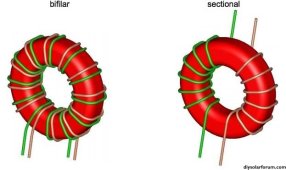They're wound exactly like the 'sectional' image in
@AntronX's post above.
Field from the two wires cancels, so current drawn by battery doesn't affect it. The wires can act as a loop antenna, so keeping them close even twisted reduces radiated power and reduces inductance. The battery itself will form a loop. I would expect the loop to emit lower frequencies in differential (capacitors absorb higher frequencies), so magnetic field but not higher frequency radio waves.
The choke tries to block common mode current, which would make the length of wire act like a whip antenna. That should attenuate switching and digital frequencies and harmonics.
Does anyone have a good lead on what type or kind that might be the best for noise attenuation for PV, battery or AC lines ?
I don’t happen to have a spectrum analyzer to see what my LV6548 twins are doing. I do know that my cell phone’s Bluetooth works better if I take a few paces away from them.
Interesting that 2.4 GHz Bluetooth is affected. We would expect digital CPU to have some emissions in that range, but not the power conversion equipment. Cell phones use loop antennas (magnetic field, reaches through your hand) rather than whip antenna (voltage field, absorbed by your hand like first generation iPhone.)
Up close, could be near-field magnetic coupling. Lower frequencies, everything is near field, but field strength drops off as r^3 not r^2 like for EM waves. Magnetic fields can be shielded somewhat with steel, more so with mu metal (expensive!) Has to be thick for low frequencies like 60 Hz, but your concerns are likely higher.
There are EMI filter cans to be designed into equipment, typically up to 20A 120/240VAC. Not high enough current for full inverter output. You could get a toroid with frequency curve showing good attenuation in the frequency range you're addressing, and wind wires as shown above.
PV and battery wires, similar use of toroids.
It is best if you have some way to measure the interference or field strength, so you can see how much benefit. Digital radio devices aren't so useful because they frequency hop and change modulation to improve communications. When I was debugging interference with a hand-held blood glucose meter (its readings would vary), I got a "business band" radio and keyed it nearby. Try an AM radio tuned between stations and if static comes and goes when inverter switched on/off, or according to load, then it could be used (for its frequency range.)

 diysolarforum.com
diysolarforum.com





